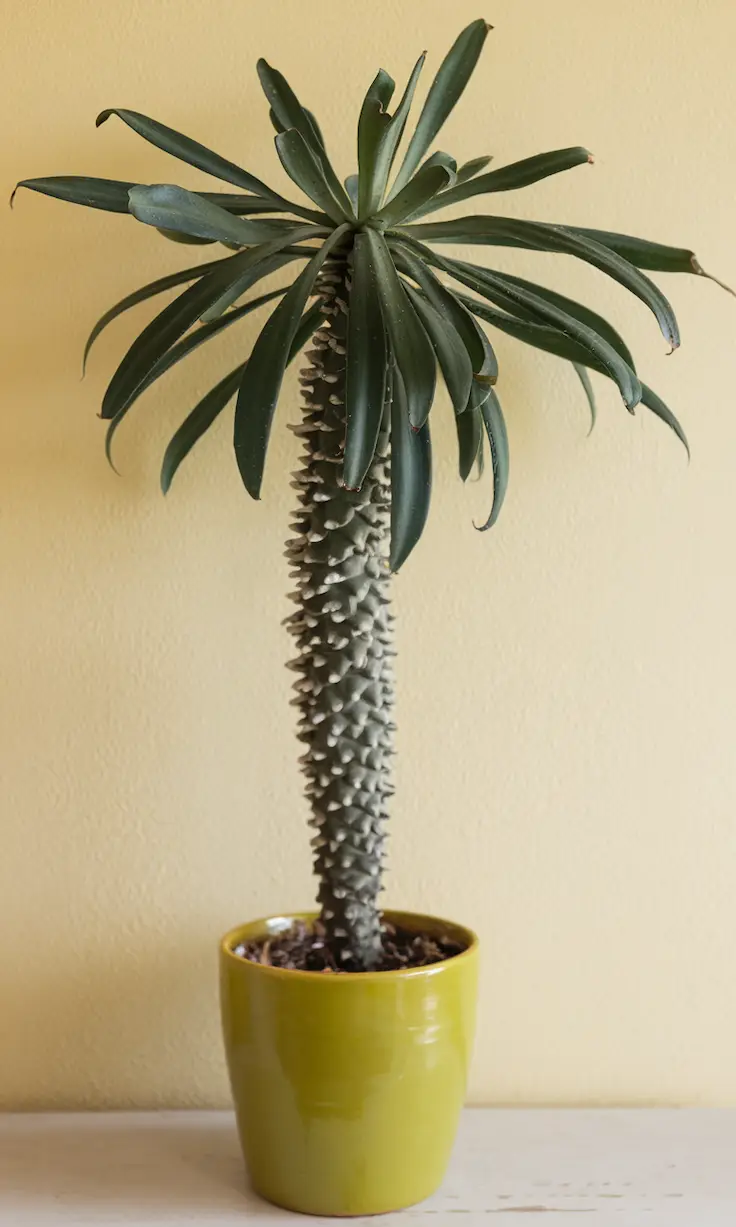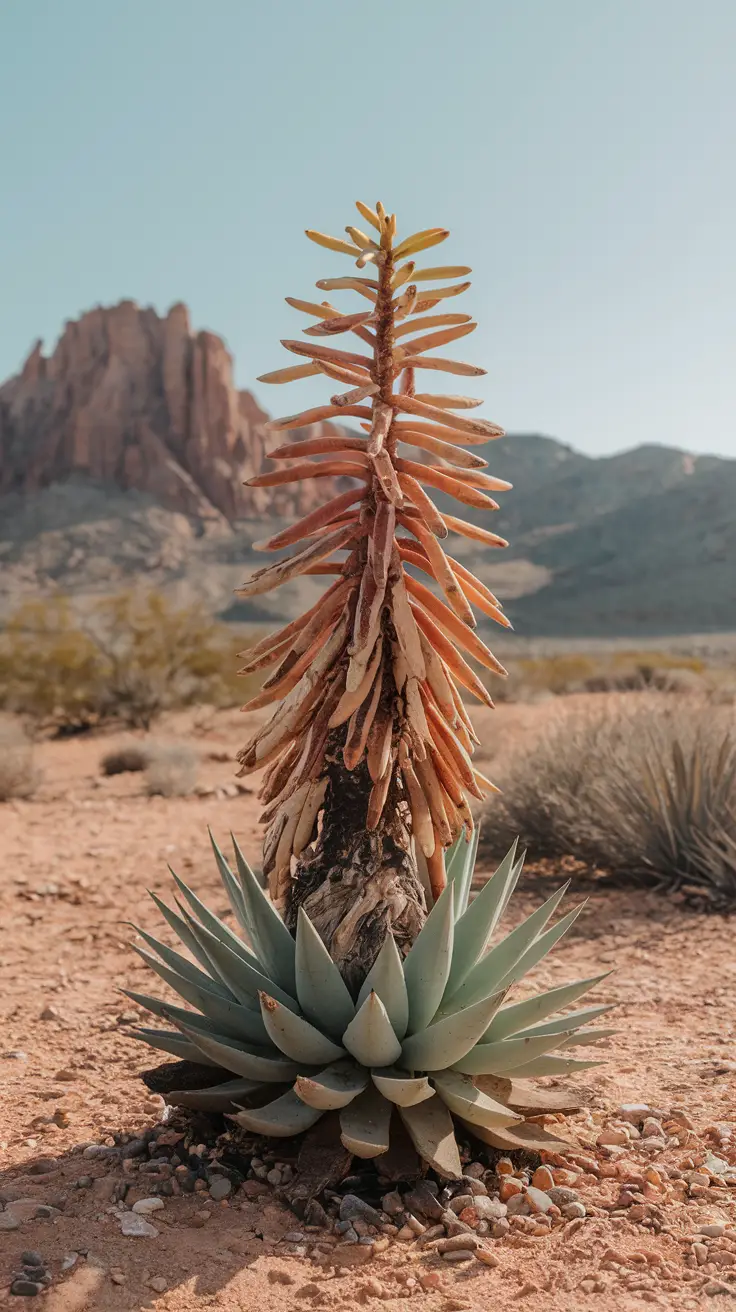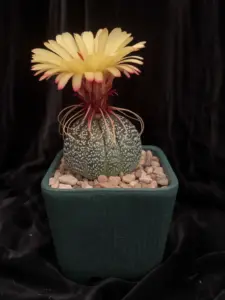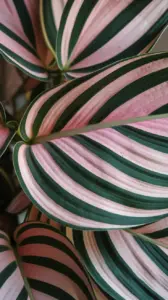Biological Features of Pachypodium Lamerei
Pachypodium Lamerei, commonly referred to as the Madagascar Palm, exhibits several distinct biological features. This unique plant displays an intriguing architecture due to its swollen trunk. The trunk serves as a water storage organ, vital for survival in arid conditions. Interestingly, Pachypodium Lamerei can grow up to 10 feet tall, particularly in its natural habitat.
Leaf Structure
The leaves of Pachypodium Lamerei are long and slender, typically measuring between 10 to 12 inches. These leaves are arranged spirally around the stem, creating a beautiful and lush appearance. When summer arrives, you can expect vibrant green foliage. This plant is also known to shed its leaves during the dry season, conserving resources.
Flowers and Reproduction
Blooms of Pachypodium Lamerei are another notable feature. The plant produces stunning, fragrant flowers that are predominantly white or pale yellow. These flowers emerge from the tips of the branches and attract various pollinators. Flowering typically occurs from late spring to early summer, adding to the plant’s appeal.
Adaptations
Pachypodium Lamerei exhibits remarkable adaptations to its environment. Its thick, spiny trunk not only stores water but also protects it from herbivores. The plant thrives in well-drained soils and prefers bright, indirect sunlight. Its resilience makes it a popular choice for gardeners.
| Feature | Description |
|---|---|
| Height | Up to 10 feet |
| Leaf Size | 10 to 12 inches |
| Flower Color | White or Pale Yellow |
| Habitat | Arid regions of Madagascar |
In conclusion, the biological features of Pachypodium Lamerei make it not only a fascinating plant but also a resilient survivor in its native habitat.

History and Cultural Significance
Pachypodium Lamerei, commonly known as the Madagascar Palm, holds a unique place in botany and culture. Indigenous to Madagascar, its striking appearance captures the imagination of many people. This succulent can grow an impressive height, showcasing its thick trunk and spiky leaves. Its natural habitat is primarily in the arid, dry regions of Madagascar, which influences its growth patterns and care requirements.
Cultural Importance
The Pachypodium Lamerei is often associated with Madagascar’s rich biodiversity. It symbolizes resilience, thriving in harsh environments. Locals regard it as a plant of strength and endurance, often using it in traditional practices. This plant also plays a role in local ecosystems, supporting various species that rely on its structure for shelter.
Gardening and Aesthetic Value
In gardening, Pachypodium Lamerei serves dual purposes. Firstly, it functions as an eye-catching ornamental plant due to its unique shape and striking foliage. Secondly, it requires minimal maintenance, making it suitable for various gardening enthusiasts. Moreover, it aligns with contemporary design trends that value plants with dramatic silhouettes.
- Pachypodium Lamerei can grow several feet tall if kept in ideal conditions.
- This plant flourishes best in well-draining soil.
- It is drought-resistant, requiring infrequent watering.
- Many people find it complements modern home decor beautifully.
Overall, Pachypodium Lamerei embodies both aesthetic beauty and cultural richness. Its presence in homes and gardens further emphasizes the connection between nature and human creativity. Whether you are a seasoned plant enthusiast or a novice gardener, this plant is a compelling choice.

Ideal Growing Conditions for Pachypodium Lamerei
Pachypodium Lamerei, often referred to as Madagascar Palm, thrives in specific conditions. Understanding its ideal environment ensures robust growth and vibrant health. This plant prefers a warm climate with ample sunlight. It flourishes best in temperatures between 70°F and 90°F (21°C to 32°C).
Light Requirements
Pachypodium Lamerei requires bright, indirect sunlight. While it can tolerate some direct sunlight, too much can scorch its leaves. Aim for at least 6 hours of bright light each day. If grown indoors, a south-facing window is ideal.
Soil and Watering
Proper soil is crucial for the health of Pachypodium Lamerei. A well-draining cactus mix is recommended. The roots should not sit in water. Water this plant thoroughly, but allow the soil to dry out between watering sessions. Overwatering can lead to root rot, which is detrimental to its health.
Humidity and Temperature
This plant is quite tolerant of low humidity levels. However, it appreciates occasional misting, especially in dry climates. Keep the temperature consistent, avoiding sudden drafts or cold air. If grown indoors, maintain a stable environment.
Fertilization
Fertilizing is essential during the growing season. Use a diluted cactus fertilizer every 4 to 6 weeks from spring to fall. In winter, reduce feeding as the plant enters dormancy. Be cautious not to over-fertilize, as it can harm Pachypodium Lamerei.
| Condition | Ideal Range |
|---|---|
| Temperature | 70°F to 90°F (21°C to 32°C) |
| Light | Bright, indirect sunlight |
| Soil | Well-draining cactus mix |
| Humidity | Low, occasional misting |
By following these guidelines, you will create an optimal environment for Pachypodium Lamerei. This will encourage healthy growth and lush foliage.

Plant Care and Maintenance
Pachypodium Lamerei requires careful attention to ensure it thrives. This unique succulent benefits from bright, indirect sunlight. Ideally, place it near a window but shield it from harsh afternoon rays. Overexposure to sun can scorch the leaves, so it’s essential to find a balanced spot.
Watering
When it comes to watering, the rule of thumb is to let the soil dry out between waterings. This plant is drought-tolerant, so less is more. Water thoroughly, allowing excess to drain. Typically, watering every two to three weeks during the growing season suffices.
Soil and Fertilization
Use a well-draining soil mix. A cactus or succulent mix works excellently. Fertilizing can enhance growth, but limit it to once a month during spring and summer. Opt for a balanced, diluted fertilizer to avoid root burn.
Temperature and Humidity
Pachypodium Lamerei prefers warmer conditions. Maintain temperatures between 70°F to 85°F (21°C to 29°C). This plant does not tolerate frost. Additionally, average household humidity levels are mostly acceptable, but avoid placing it in overly humid rooms.
General Care Tips
- Rotate the plant occasionally for even growth.
- Monitor for pests such as mealybugs and spider mites.
- Maintain cleanliness by dusting the leaves.
- Repot every few years to refresh the soil and accommodate growth.
- Prune dead or damaged leaves to promote healthy growth.
Overall, with proper care, Pachypodium Lamerei can flourish, adding unique beauty to your space. Always keep an eye on its environmental needs. Regularly assess its light, water, and temperature conditions for optimal health.

Propagation Techniques for Pachypodium Lamerei
Propagating Pachypodium Lamerei can be an exciting endeavor for plant enthusiasts. This process requires specific techniques to ensure success. One popular method for propagation is through seed germination. Seeds should be sown in a well-draining soil mix. This helps to prevent excess moisture, which can lead to rot.
Germination Tips
Ensure the seeds are fresh and not older than a year. After sowing, lightly cover them with soil and mist with water. Maintain a warm, humid environment for optimal germination. Typically, germination can occur within two to three weeks. Thus, patience is key during this phase.
Cutting Techniques
Another effective method involves taking cuttings from a healthy Pachypodium Lamerei plant. Select a healthy stem and use a sterilized sharp knife to take a cutting. Allow the cutting to dry for several hours. This forms a callus over the cut area. The callus helps prevent rot when planted.
Next, plant the cutting in a succulent or cactus mix. Water it lightly to avoid saturating the soil. Place the pot in a warm, bright location away from direct sunlight. Roots usually develop within several weeks when conditions are right.
General Care After Propagation
Regardless of the propagation method, proper care is crucial. Water the plants sparingly; overwatering can be detrimental. Once they establish, they thrive in bright indirect sunlight. Young Pachypodium Lamerei plants benefit from occasional fertilization. Use a balanced fertilizer diluted to half strength every month during the growing season.
In summary, propagating Pachypodium Lamerei is approachable. With the right techniques, you can enjoy watching these unique plants grow and thrive. Both seed propagation and cuttings yield promising results for dedicated plant lovers.
Common Problems and Solutions
Pachypodium Lamerei, often called Madagascar Palm, is a unique succulent that can face various challenges. Understanding its common issues and solutions can lead to better care. Recognizing early signs can help maintain the plant’s health. Here are key problems you might encounter:
- Overwatering: This plant requires well-drained soil. Too much moisture can cause root rot. Ensure the pot has drainage holes.
- Underwatering: On the flip side, too little water leads to dehydration. Regularly check the soil moisture.
- Pests: Spider mites and mealybugs are common pests. Inspect the leaves regularly. If found, treat with insecticidal soap.
- Light Issues: Pachypodium Lamerei loves bright, indirect sunlight. Insufficient light can slow growth and cause leaf drop.
- Temperature Sensitivity: This plant prefers warm temperatures. Cold drafts can lead to stress and potential leaf loss.
Here’s a table summarizing problems and their solutions:
| Problem | Solution |
|---|---|
| Overwatering | Allow soil to dry out between waterings. |
| Underwatering | Water regularly, ensuring the top inch of soil is moist. |
| Pests | Use insecticidal soap or neem oil for treatment. |
| Light Issues | Provide bright, indirect sunlight for optimal growth. |
| Temperature Sensitivity | Keep the plant in a warm environment, avoiding cold drafts. |
By addressing these common problems, you can ensure the well-being of your Pachypodium Lamerei. Regular care and monitoring can prevent these issues from escalating. Stay vigilant, and your plant will thrive!
Seasonal Care Adjustments
Pachypodium Lamerei thrives in a warm climate. Seasonal changes can affect its growth. In spring and summer, provide more sunlight. Increase watering frequency to keep the soil slightly moist. However, avoid waterlogging. During autumn, reduce watering to allow the plant to prepare for dormancy. Monitor humidity levels as well. In winter, limit sunlight exposure since it needs less light. Water the plant sparingly, allowing the soil to dry completely between waterings.
Tips for Seasonal Adjustments
- Provide bright, indirect sunlight for optimal growth.
- Use a well-draining soil mix to prevent root rot.
- Adjust watering frequency according to seasonal changes.
- Maintain temperatures above 60°F (15°C) during winter.
- Fertilize during the growing season to promote healthy growth.
Microclimate Setup Tips
Setting up the right microclimate for your Pachypodium Lamerei is essential for its growth and overall health. These unique plants thrive in specific conditions that mimic their native habitat.
Temperature and Humidity
Pachypodium Lamerei prefers a warm environment. Ideally, maintain temperatures between 70°F and 85°F during the day. At night, a slight drop to 60°F to 65°F is beneficial. Additionally, moderate humidity levels help, but avoid excessive moisture as it leads to root rot.
Light Requirements
This plant enjoys bright, indirect light. Placing it near a south or west-facing window is ideal. If you notice the leaves losing their color, it might be getting too much direct sunlight.
Watering Practices
Water Pachypodium Lamerei thoroughly, allowing the soil to dry out between watering sessions. Overwatering can harm the roots. Generally, once every two weeks is sufficient during the growing season.
Soil Type and Fertilization
Use a well-draining soil mix designed for cacti or succulents. Mixing in perlite or sand enhances drainage. Fertilize the plant monthly during the growing season with a balanced fertilizer diluted to half strength.
Additional Tips
- Monitor the plant regularly for pests.
- Rotate the plant occasionally for even light exposure.
- Avoid placing the plant near cold drafts or heaters.
- Consider using a humidity tray for added moisture.
By following these tips, you can create the perfect microclimate for your Pachypodium Lamerei, ensuring it thrives and remains healthy.
Frequently Asked Questions
Pachypodium Lamerei is a unique succulent that often raises questions among plant enthusiasts. One common question is about its care. This plant thrives in bright light but needs protection from direct sunlight to prevent leaf scorch. Watering should be infrequent; over-watering can lead to root rot. It’s essential to let the soil dry out between waterings.
Another frequent inquiry is regarding its growth rate. Pachypodium Lamerei grows slowly, typically reaching a height of 3 to 4 feet indoors. However, under ideal conditions, it can grow taller. Furthermore, many people wonder about its toxicity. Thankfully, while it can be mildly toxic if ingested, it’s not considered highly dangerous.
People also ask about the ideal temperature. This plant prefers warm environments, ideally between 65°F and 90°F. It cannot tolerate frost, so it’s essential to keep it indoors during colder months. Lastly, some individuals are curious about propagation methods. The best way to propagate Pachypodium Lamerei is through seeds or stem cuttings, but this requires patience and care.
Summary and Recommendations
Pachypodium Lamerei, often revered for its striking appearance, thrives in well-draining soil. This attractive succulent features a tall, spiny trunk. It’s crucial to provide bright light for optimal growth. While it can tolerate some neglect, regular watering during the growing season promotes health.
When considering this plant, ensure it is placed in a warm environment. Avoid excessive moisture, as it may lead to root rot. During winter, cut back on watering. Use a balanced fertilizer during its active growth period, usually in spring and summer.
For optimal results, repot every few years, using a cactus or succulent mix. This practice encourages healthy root development. Always wear gloves when handling, as the spines can prick the skin. Ultimately, with care, Pachypodium Lamerei makes a stunning addition to any collection.






